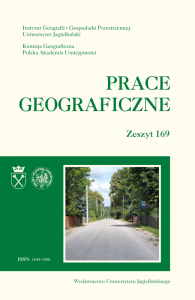Możliwości identyfikacji reliktów wyludnionych wiejskich jednostek osadniczych i przekształceń zachodzących w ich obrębie w świetle nieinwazyjnych metod i technik badawczych – studium wsi Bartki z terenu dawnych Prus Wschodnich
Possibilities of identifying the relics and transformations of depopulated settlement units in the light of non-invasive research methods and techniques – the case study of Bartki village from the area of former East Prussia
Author(s): Anna MajewskaSubject(s): Archaeology, Historical Geography
Published by: Wydawnictwo Uniwersytetu Jagiellońskiego
Keywords: abandoned villages; archaeology of the contemporary past; cultural landscape; historical geography; LiDAR; Masuria;
Summary/Abstract: The article tackles the issue of the identification of relics and type of transformations in the rural cultural landscape of Warmia and Masuria, which took place as a result of the depopulation of localities due to the course and consequences of World War II. The incorporation of the southern part of East Prussia into Poland in 1945 initiated a number of social, economic, and cultural changes. Above all, the region was affected by huge migratory movements. These started with the hurried escape of the local civilian population fleeing from the Red Army that conquered the area in the winter of 1944–1945. Subsequently, the displacement of the German people and the unstable political situation that made it difficult to maintain habitation contributed to the depopulation of hundreds of villages, manor houses, foresters’ lodges, and small settlements. Today, in Poland’s incorporated part of former East Prussia, there are about 788 abandoned localities. The extent to which the rural landscape has changed as a result of the total depopulation of hundreds of settlement units has not yet been determined. The purpose of the research was to diagnose the processes that occurred in the material structure of the landscape of Warmia and Masuria after the continuity of habitation had been interrupted, based on data collected due to on-site prospections, searches, and spatial analyses. The elaboration presents possibilities for identifying transformations that occur after depopulation on the basis of the results of multifaceted spatial analyses carried out with the use of GIS tools. Particularly noteworthy is the use of detailed elevation data obtained from airborne laser scanning, which data largely condition not only identification of surface relics but also the degree of degradation of rural structures. The issues concerning the diagnosis of transformations are discussed using, as an example, the study of one of the depopulated localities – Bartki – a former settlement that lies in Olecko County (Warmia-Masuria Province).
Journal: Prace Geograficzne
- Issue Year: 2022
- Issue No: 169
- Page Range: 7-42
- Page Count: 36
- Language: Polish

